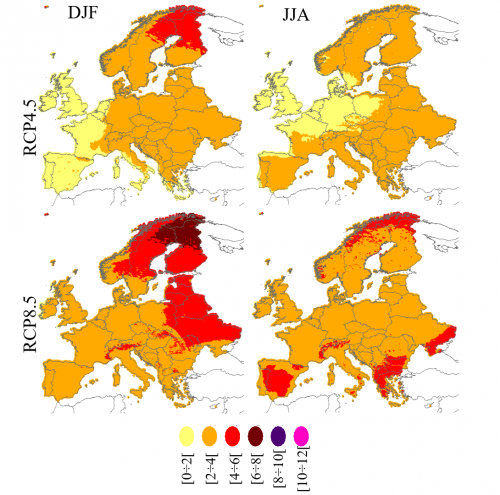Oct 15 2020
Buildings and infrastructure also need to cope with climate change. It is vital to update structural design regulations to optimize European climate resilience and guaranteeing the safety of structures that are predicted to suffer from deviations in atmospheric variables and more often, powerful, and extreme weather events.
 Mean temperature anomaly for DJF (December-January-February) and JJA (June-July-August) seasons under the concentration scenarios RCP4.5 (first row) and RCP8.5 (second row); 2056–2085 vs 1971–2000. Data processing by DATACLIME. Image Credit: Willian Justen de Vasconcellos on Unsplash.
Mean temperature anomaly for DJF (December-January-February) and JJA (June-July-August) seasons under the concentration scenarios RCP4.5 (first row) and RCP8.5 (second row); 2056–2085 vs 1971–2000. Data processing by DATACLIME. Image Credit: Willian Justen de Vasconcellos on Unsplash.
In 2017, the Joint Research Centre (JRC)—the European Commission’s science and knowledge service—set up the scientific network on the adaptation of structural plans to climate change.
A network of professionals, including the CMCC Foundation, focused on examining how research can support decision-makers to consider predicted changes in the climate system while modifying the Eurocodes, the European regulations for structural design.
The role of anticipated temperature increases in Europe in the coming decades is at the core of two new reports prepared by the network. The focus of the first one is on thermal actions on structures (Thermal design of structures and the changing climate), and that of the other is on corrosion in the backdrop of a changing climate (Expected implications of climate change on the corrosion of structures).
In their input to these publications, CMCC scientists from the REMHI division—Regional Models and geo-Hydrological Impacts—examined temperature differences and other atmospheric variables predicted for the next 50 years, a period that typically signifies the usage life of a structure constructed today. The study used the results of the forecasts found in the EURO-CORDEX ensemble.
The first research studied the “worst-case” scenario (RCP8.5)—or rather the “high emissions scenario”—and forecasts an increase in greenhouse gas emissions at existing rates for the future as a reference scenario to examine the case study of Italy, noting for the whole country a related temperature peak by 2070.
Taking as a reference the maximum and minimum temperature levels that are expected to occur at least once in 50 years, we found a significant increase in both the maximum values of the maximum temperature—which in some areas of Italy can reach +6°C—and the maximum values of the minimum temperature—with variations up to +8°C in the mountain ranges.
Guido Rianna, Study Author and Researcher, CMCC Foundation
Rianna added, “The increase in minimum temperature may not be that relevant for buildings, as it implies that constructions will be exposed to less rigid temperatures than today, and therefore less stress. Instead, the increase in the maximum expected temperature could lead to the need for a revision of building standards to ensure the safety of constructions: linear structures such as bridges and viaducts, for example, are subject to thermal expansion.”
The second publication relates to a research work—carried out on a European scale—on the predicted deviation in air temperatures and relative humidity in 2070 caused by climate change, the goal of which is to understand the degree to which these atmospheric variables may influence the corrosion of buildings in the years ahead.
In fact, rising temperature and relative humidity can speed up the corrosion process of steel bars or structures within reinforced concrete, which compromises their resistance and thus risks the safety of buildings.
“Climate simulations tell us that temperatures in the next 50 years are increasing significantly throughout Europe, albeit with regional differences,” adds Rianna. “The extent of this increase is between 3 and 5 °C on average and depends on the climate change mitigation measures that will be implemented.”
Even in this case, the authors note that a revision of the Eurocodes may be essential to take into consideration the speeding up of the corrosion process in buildings triggered by climate change and offer measures to restrict it.
According to the study, future variations in relative humidity are not noteworthy. This signifies that the true engine of corrosion processes of structures on a European scale will be characterized by a rise in temperature, instead of humidity.
These publications are the result of a series of studies aimed at supporting the definition and revision of the European standards for structural design most suited to the world of the future. After having analyzed, in the past, the impact of snowpack and in these recent studies, thermal impact, the next step will be to study the impact of wind.
Paola Mercogliano, Director, REMHI division, CMCC Foundation
Mercogliano continued, “Our ultimate goal is to support policy-makers and builders with sound services and information for the update of current structural design standards, considering the various atmospheric phenomena and the different types of constructions, in order to allow for the implementation of effective policies and adaptation actions.”
Journal Reference
Athanasopoulou, A., et al. (2020) Thermal design of structures and the changing climate. JRC Technical Report. doi.org/10.2760/128894.